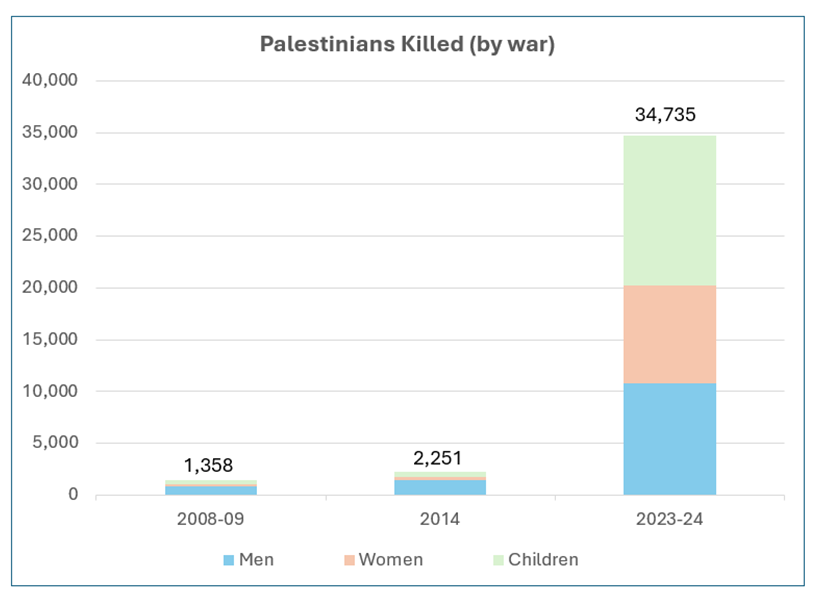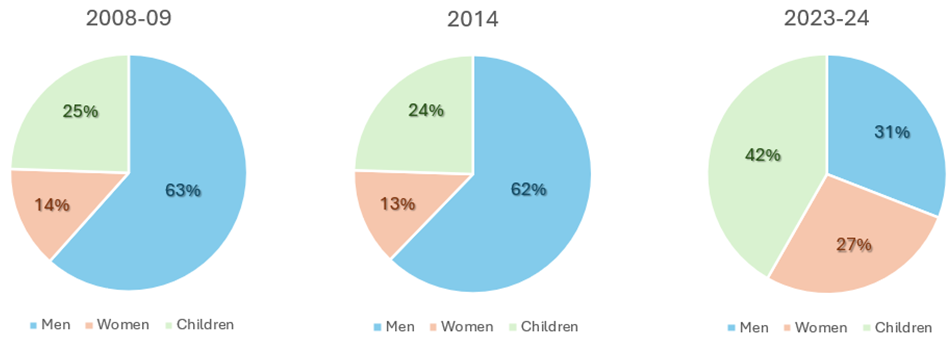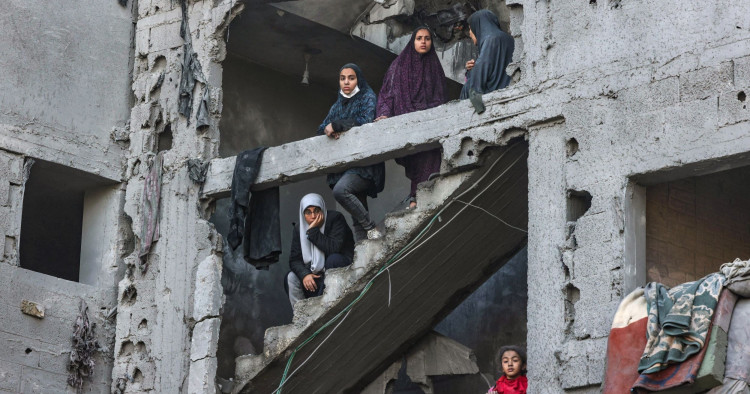Israel’s ongoing war on Gaza has caused massive destruction in both human and material terms. In less than six months, close to 35,000 people have been killed, including more than 14,500 children, while most of Gaza’s civilian infrastructure has been wiped out. Israel’s conduct in the war has even led the International Court of Justice (ICJ) to rule that there is a “plausible” case for genocide. Israeli leaders insist that such destruction is not intentional but is unavoidable given Hamas’ use of “human shields” and the fact that the militant group has embedded itself among the civilian population and routinely operates from civilian structures like hospitals and schools. Although Israel has made similar claims in previous wars with Hamas in Gaza, the “human shields” argument has now also become a standard talking point in the American political discourse, invoked by everyone from President Joe Biden on down, and ranging from Sen. Marco Rubio on the right to Sen. Bernie Sanders on the left, along with a wide array of US journalists, analysts, and commentators across the political spectrum.
But are such assertions valid? Is it true that Hamas uses Palestinian civilians as human shields? As importantly, is that enough to explain the unprecedented scale of devastation and death in Gaza?
The answers to these questions are likely to come as a surprise to many. Despite the ubiquitousness of the allegation, the Israeli claims that Hamas systematically and intentionally uses Palestinian civilians as human shields does not hold up to scrutiny. Moreover, even if it were true, the assertion would still not be enough to justify or explain the magnitude of death and destruction in Gaza. Indeed, the massive civilian casualties and destruction inflicted on Gaza are best understood not as a result of human shields but of Israeli policy and military conduct, which has both blurred the distinction between civilian and military targets and inflicted deliberately disproportionate levels of destruction. Far from explaining the current devastation in Gaza, therefore, the “human shields” charge has become a way to shield Israel from legitimate scrutiny and accountability.
“Human shield” under international law
International humanitarian law has several fundamental principles to determine the range of what constitutes lawful military activity, the most important of which are the standards of “distinction” and “proportionality.” Distinction refers to the obligation to distinguish between the (binary) categories of military and civilian. However, even in the case of a legitimate military target, under the principle of proportionality, civilian harm is justified only if it is not excessive in relation to the concrete and direct military advantage anticipated.
International law also addresses certain situations where parties to a conflict could take advantage of these principles, including the use of human shields. The standard definition of a human shield in international law is an intentional co-location of military objects (personnel or materials) and civilians with the specific intent of deterring or preventing the targeting of those objects. Though considered to be customary law, this prohibition appears in several conventions and is obligatory for state and non-state actors alike. Although parties in an international conflict must take measures to protect civilians and civilian facilities from attack, merely operating in proximity to civilians is not in and of itself sufficient to prove a violation of the human shield clause. The operation must also be carried out with the intention — or at least the hope — that doing so will affect the opponent’s offensive, which legally is very difficult to prove.
Human shields are often used as a technique in asymmetric armed conflicts, especially those conducted in densely populated urban areas, such as can be found throughout most of the Gaza Strip. Israel accuses Hamas of using human shields in two ways, first by conducting military operations in proximity to residential areas and critical infrastructure — such as hospitals and schools — in an attempt to deter the Israel Defense Forces (IDF) from attacking these areas, and second by using Israeli civilian hostages to shield members of Hamas’ senior leadership from attack.
While there have been cases of Hamas fighters and weapons located in or near civilian structures in violation of international law, whether these were done deliberately to deter attack is not clear. What is clear is that Gaza is among the most densely populated areas in the world, with some 2.3 million people packed into less than 140 square miles. Thus, there are very few spaces that would not be in proximity to civilians and critical infrastructure. Moreover, the need to demonstrate intent further complicates the matter. Even so, while no studies have yet been conducted on the current war in Gaza, both Human Rights Watch and Amnesty International have investigated similar allegations in previous wars and found no evidence of Hamas using human shields.
Erasing the distinction between civilian and military
Even if Hamas were violating the prohibition against human shields, this does not absolve Israel of its obligations under international law to avoid harming civilians and to limit attacks to military targets. In reality, however, there is overwhelming evidence that Israel’s conduct throughout the war has not only consistently violated the basic principles of distinction and proportionality but has done so rather egregiously and as a matter of policy.
With regard to the issue of civilian versus military targets, which, once again, international humanitarian law experts widely treat as mutually exclusive categories, Israel has manipulated (and effectively erased) this distinction by creating an entirely different standard. Instead of differentiating between “military” and “civilian,” Israeli military officials talk in terms of “involved” and “uninvolved” persons and targets. Exactly who or what might qualify as “involved” is unclear, but it is clearly broader than the standard categories of military or militant. For example, does a parent who expresses support for the militant actions of his son make him a legitimate target? Would any of the thousands of civil servants employed in the various civilian ministries of the Hamas-run government qualify as “involved” and thus deemed legitimate targets?
Under humanitarian international law, the answer is unequivocal: The parent and the civil servant, unless they directly take up arms or otherwise participate in warfare, are both considered civilians and thus are protected. Under the Israeli definition of “involved,” which applies to anyone or anything with any affiliation with Hamas, both could be considered legitimate military targets. Israel seems to apply similar standards to structures and institutions as well, broadening the scope of constituting “legitimate” attacks. Indeed, because Hamas has been the de facto government in Gaza, tens of thousands of civilians who have never participated in any military or armed activity, as well as official or semi-official institutions, such as hospitals, universities, media outlets, or even cultural sites — all of which have been targeted by Israel — could likewise be considered legitimate targets under the Israeli definition.
The numbers speak for themselves
In terms of the proportionality requirement, the evidence is even more overwhelming. In fact, disproportionality is built into Israel’s military doctrine. According to the so-called Dahiya Doctrine (named after the Beirut neighborhood flattened by the IDF in 2006), the use of overwhelming, disproportionate force represents an essential component of Israel’s military deterrence. As Maj. Gen. Gadi Eisenkot explained, “What happened in the Dahiya quarter … will happen in every village from which Israel is fired on. … We will apply disproportionate force on it and cause great damage and destruction there. From our standpoint, these are not civilian villages, they are military bases.”
That disproportionality has increased dramatically in the current assault on Gaza, particularly with regard to civilian casualties and infrastructure. Just two days after the Oct. 7 attack by Hamas, Israeli Defense Minister Yoav Gallant declared that he had “released all restraints” and warned that “Gaza won’t return to what it was before.” Similarly, the chief spokesperson of the Israeli military, Daniel Hagari, said that “right now we’re focused on what causes maximum damage.”
These are not mere words. Both the scale and intensity of the current Israeli offensive in Gaza have far exceed anything seen before, with an average of 428 targets per day — more than four times the daily average in the last major war in 2014. Whereas previous wars might have allowed for dozens of civilian deaths in a single strike, Israeli tolerance for collateral damage has scaled up significantly. According to +972 Magazine, Israeli military planners knowingly signed off on the killing of hundreds of civilians in pursuit of a single Hamas target. There have been several instances in which 100 or more civilians were killed in a single airstrike.
The use of artificial intelligence (AI) to generate much larger numbers of targets, which include automatic estimates of how many civilians would be killed if the respective target is hit, has greatly enhanced the deadliness and destructive capacity of Israel’s offensive. In addition to the massive death toll, Israel’s assault has, to date, destroyed 60% of Gaza’s housing stock (some 360,000 homes), all 12 of its universities, most of its 36 hospitals, hundreds of cultural, civic, and religious sites, along with one-third of its agricultural land — in other words, the very institutions that sustain life for Gaza’s population.
Such comprehensive devastation cannot be explained in terms of “human shields” or even collateral damage. At best, as one Israeli military source explained, the goal is to harm Palestinian civil society and “create a shock” that may ultimately “lead civilians to put pressure on Hamas.” At worst, the goal is to render all or most of Gaza permanently uninhabitable with the ultimate aim, as Prime Minister Benjamin Netanyahu put it, of “thinning out” Gaza’s population. Although collective punishment has long been a mainstay of Israel’s occupation, it has reached new levels in the course of Israel’s war on Gaza, as demonstrated rather alarmingly by its policy of severely restricting humanitarian assistance to the point of inducing famine.
Unsurprisingly, Israel’s current war on Gaza is even more disproportionate in its deadliness than any previous ones. While Israeli officials continue to insist they are doing “everything possible” to minimize civilian casualties, the numbers tell a very different story. In comparing civilian casualties in the current Israeli assault to those from previous wars in the Gaza Strip, not only has the scale of Palestinian deaths in the current war increased exponentially, but the proportion of children and women killed or injured has nearly doubled. As the graphs (produced by the authors) below show, women and children make up 69% of the total killed in the current war, as compared with 39% and 38% in 2014 and 2008-09, respectively. In fact, the number of children killed alone in this war exceeds those killed in all the wars around the world for the past four years combined.


Since we do not have figures specifically for “civilians” killed and injured for each war, the tallies of women and children represent only a conservative estimate of civilian casualties (for example, according to the United Nations, 851 out of the 1,401 men killed in the 2014 Gaza war, or roughly 60%, were civilians). According to the Gaza Health Ministry numbers — the only official estimates available for casualties in Gaza but widely regarded as reliable and used by the Israeli military itself — the current death toll of roughly 35,000 does not account for the thousands who are still buried under the rubble and presumed dead. Even if we assume that Israel’s conduct during previous wars was within the boundaries of international law (which most human rights groups would dispute), this cannot explain such a dramatic increase in the current proportion of civilian casualties. This disparity also discounts the “human shields” argument.
Indeed, neither the appalling number of civilian casualties nor the scale of devastation in Gaza can be explained by Hamas’ use of human shields, for which the evidence is spotty at best. The persistence of the “human shields” charge, despite the notable lack of evidence, may have more to do with undercurrents of Islamophobia and anti-Palestinian racism — i.e., the blind belief that only Muslims and/or Palestinians would be savage enough to hide behind women and children. After all, despite the fact that Israel’s defense ministry and military headquarters is located in the heart of a densely populated area in Tel Aviv, no serious commentator would accuse Israel of using human shields.
Regardless, even if it were true that Hamas was using human shields, this still would not absolve Israel of its obligations under international law with regard to the protection of civilians. Yet not only has Israel not done its best to limit civilian harm, the evidence strongly suggests that the opposite is true. In short, the reasons for the massive scale of death and destruction in Gaza have to do with Israeli policy and conduct throughout the war, including effectively erasing the distinction between civilian and military targets and vastly increasing the disproportionate destruction of the basic institutions of civilian life. In that sense, the “human shields” charge has become little more than a distraction from Israel’s daily and increasingly egregious violations in Gaza in order to shield it from any meaningful scrutiny and accountability.
Khaled Elgindy is a senior fellow at the Middle East Institute and the director of its Program on Palestine and Israeli-Palestinian Affairs. He is the author of the 2019 book Blind Spot: America and the Palestinians, from Balfour to Trump.
Eyal Lurie-Pardes is a Visiting Fellow in the Program on Palestine and Palestinian-Israeli Affairs at the Middle East Institute after receiving the competitive University of Pennsylvania Carey Law School LLM Post-Graduate Fellowship.
Photo by MOHAMMED ABED/AFP via Getty Images
The Middle East Institute (MEI) is an independent, non-partisan, non-for-profit, educational organization. It does not engage in advocacy and its scholars’ opinions are their own. MEI welcomes financial donations, but retains sole editorial control over its work and its publications reflect only the authors’ views. For a listing of MEI donors, please click here.













